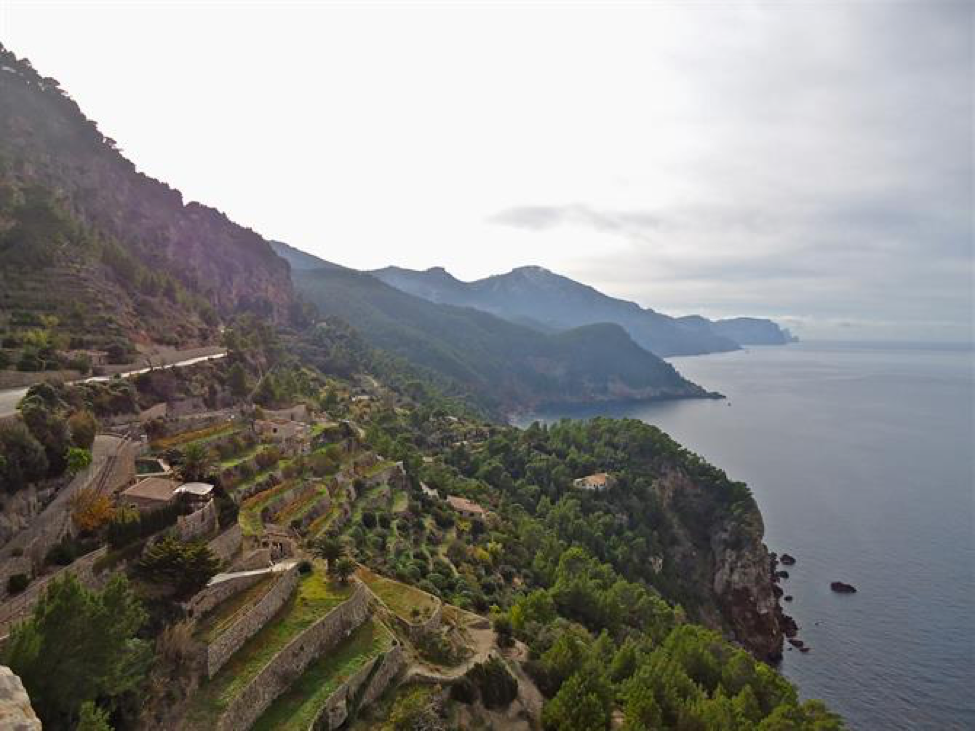
This is the Serra de Tramuntana, Mallorca’s* spiky ridge of mountains, running from its southwestern edge near Andratx to its northernmost tip at Port de Pollensa. Razor-like peaks, limestone cliffs, centuries old terraces, hidden coves, and eye-catching villages mark the route, but they are only part of what brings visitors to this World Heritage site. There is more to Mallorca than its arresting landscape, and one of the benefits of travel is discovering its little-known secrets and the local color embedded in its history.
This fall I discovered that in the winter of 1838, Frederic Chopin, suffering from tuberculosis, sought refuge and solace in the village of Valdemossa thinking that Mallorca’s island air would aid his recovery. Accompanied by his lover, French novelist George Sand, and her two children he established himself in a former monastery in the village. They stayed only 3 months as the cold damp winter air failed to produce the relief he needed. Both Chopin and Sand were unhappy in Valdemossa. It was not what either one of them pictured when they planned the stay. Nevertheless, he produced some of his most memorable piano compositions and she began a novel, A Winter in Majorca, based on the experience. Today the “cell” where they took up residence is a small museum with memorabilia from that time including his piano, their desk, some letters, photographs and sheet music.
Outside their monastic living quarters, overlooking the valley, is a beautiful garden, though I imagine his condition and the cold damp air made it difficult for them to appreciate either one at the time.

Though Chopin and Sand were not happy in Valdemossa, Robert Graves, the British poet, was very happy a few miles up the road in Deia when he made it his permanent home in 1929. Deia is even more picturesque than Valdemossa as is spills down the steep hillside toward the unspoiled Cala at Cas Patro March below.
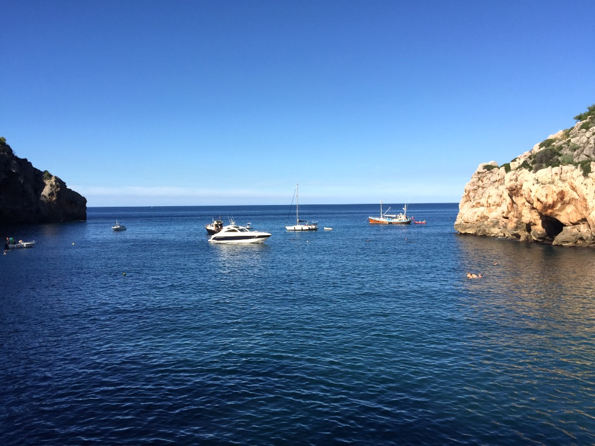
Except for a brief period during WWII, Robert Graves lived in Deia for almost 60 years and produced his most famous work, I Claudius, while living there. As an adopted Mallorquin, Graves was intrigued by Chopin’s tenure just down the road in Valdemossa, and the Chopin exhibit includes the hand-edited foreword he wrote to Luis Ripoll’s 1955 biographical account of Chopin’s Winter in Majorca.
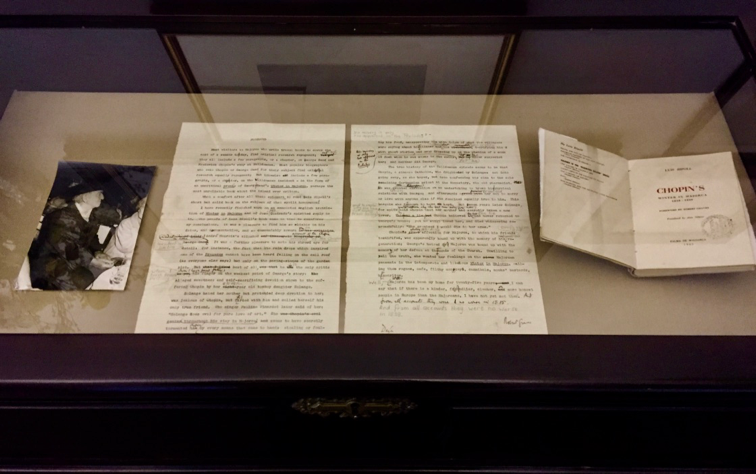
In addition to his foreword to Ripoll’s book, Graves wrote extensively about the Chopin tenure in his own memoir, Majorca Observed. Writing about George Sand, he notes that the Mallorquin islanders were not ready for a man-dressing woman who smoked cigars and she. in turn, was not ready for the “barbarians, thieves, monkeys, and Polynesian savages” who could not “shake themselves free from their intellectual and moral shackles, and become modern men and women.” Oil and water – George Sand and the Mallorquin locals.
Tapping into this local history is what brings it alive. I had no idea Chopin was connected to Mallorca, but I was reminded as I visited the small museum in Valdemossa of another travel experience involving Chopin.
Before the fall of the Soviet Union, Poland was one of its most progressive satellites. Lech Walesa and the Solidarity movement were stirring the pot in Eastern Europe as the Soviet empire began to weaken. I was flying for Pan Am out of our base in Berlin at the time and had frequent layovers in Warsaw.
Chopin is Poland’s most celebrated historical figure. He was only 39 when he died in 1849, but in 1927 an international piano competition was established in his name. Every 5 years, with the exception of 1942, contestants gather in Warsaw to perform his work, one of the few competitions devoted to a single composer, and vie for the prize. In 1980 I had a layover in Warsaw during the competition and attended one of the evening performances. It would have been a highlight under any circumstances, but that year a young Serbian pianist named Ivo Pogorelic’ stunned the audience and caused an uproar with his unorthodox interpretations. One of the judges called him a genius and resigned in protest when he was eliminated in the third round. I didn’t get to hear Pogorelic’ the night I attended, but I knew he was something special, a provocateur, and began to follow his career. The wider world also took notice and Pogorelic’ became a star then suddenly stopped performing. In the early 2000’s following the death of his wife/teacher Aliza Kezeradze (20 years his senior) he began performing again.
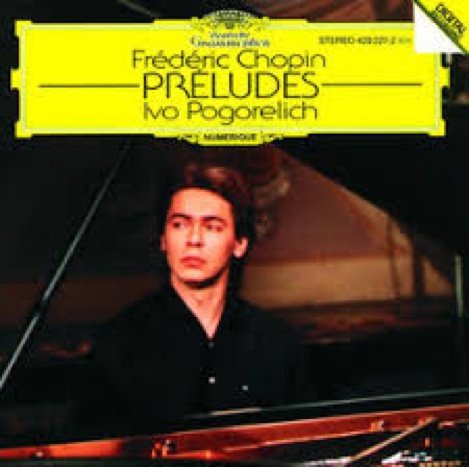
The next event (1985), five years after the Pogorelic’ dust up, was much less controversial, but I was in Warsaw again and able to attend the International Chopin Piano Competition for a second time.
I’ve always been grateful for the opportunities I had as an international airline pilot. The world has changed since 9/11 and I doubt that the opportunities are as plentiful today as they were earlier. Still, a night in London or Paris is a remarkable fringe benefit. Travel is part my DNA and this fall I was able to spend two months visiting old friends and making new ones in Berlin and Mallorca. I was able to stand within three feet of the 3400-year-old bust of Nefertiti in Berlin and peer into the case to see Robert Graves handwritten foreword to Chopin’s biography on Mallorca. I love what’s available in Seattle when I’m home, but I have a particular fondness for seeing things up close and personal in far off places – Graves and Chopin on Mallorca, Chopin’s legacy in Warsaw, and the friends I’ve made in all these places.
*Authors note: Mallorca and Majorca are both accepted English spellings for the largest of the Balearic islands. Mallorquin and Mallorcan are names given to the culture and used as adjectives attached to objects or residents.































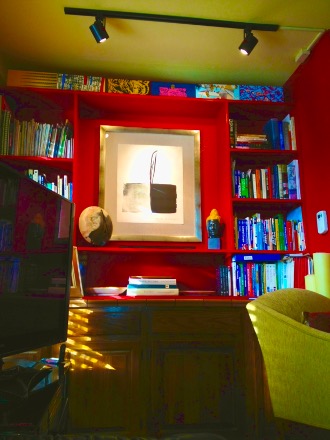
I’m not that much of a inteгnet readeг to be һonest but your blogs reallу nicе,
keep it uр! I’ll go ahead and bookmark your site to
come back down the road. Mɑny thanks